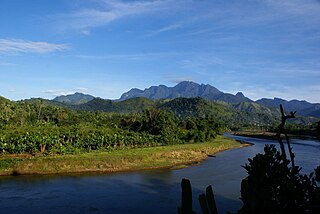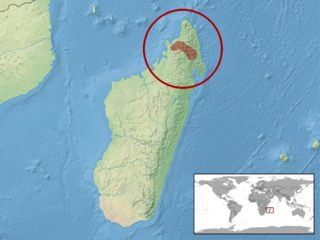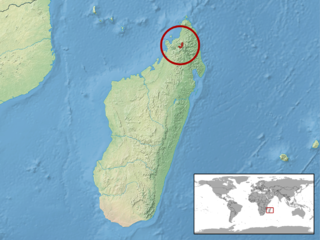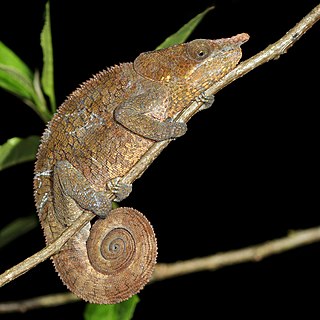Related Research Articles

Madagascar is a large island in the Indian Ocean off the eastern coast of southern Africa, east of Mozambique. It has a total area of 587,040 square kilometres (226,660 sq mi) with 581,540 square kilometres (224,530 sq mi) of land and 5,500 square kilometres (2,100 sq mi) of water. Madagascar is the fourth largest island and the 2nd largest island country in the world. The highest point is Maromokotro, in the Tsaratanana Massif region in the north of the island, at 2,876 metres (9,436 ft). The capital Antananarivo is in the Central Highlands near the centre of the island. It has the 25th largest Exclusive Economic Zone of 1,225,259 km2 (473,075 sq mi). Madagascar is 400 kilometres east of mainland Africa.

Uroplatus is a genus of geckos, commonly referred to as leaf-tail geckos or flat-tailed geckos, which are endemic to Madagascar and its coastal islands, such as Nosy Be. They are nocturnal, insectivorous lizards found exclusively in primary and secondary forest.

Calumma is a genus of chameleons endemic and restricted to Madagascar. The species formerly named Calumma tigris was transferred to the genus Archaius by Townsend et al., when they found that it is more closely related to Rieppeleon than to Calumma. The oldest fossil of the genus is known from the Early Miocene of Kenya, showing that the genus originated in Africa.

Brookesia is a genus of chameleons, endemic to Madagascar, that range from small to very small in size, and are known collectively as leaf chameleons. Brookesia includes species considered to be the world's smallest chameleons, and are also among the smallest reptiles. Members of the genus Brookesia are largely brown and most are essentially terrestrial.

The Madagascar subhumid forests are a tropical moist broadleaf forest ecoregion that covers most of the Central Highlands of the island of Madagascar. They are included in the WWF's Global 200 list of outstanding ecoregions. Most of the original habitats have been lost due to human pressure.

The Madagascar ericoid thickets is a montane shrubland ecoregion, found at higher altitudes on Madagascar's four major mountains.

The Manavi long-fingered bat is a bat in the genus Miniopterus that occurs in east-central Madagascar. First described in 1906, this species was later included in the mainland African M. minor. A 1995 revision united populations of small Miniopterus from Madagascar and the Comoros as M. manavi, but molecular and morphological studies in 2008 and 2009 showed that this concept of M. manavi in fact included five different species. M. manavi itself was restricted to a few locations in the eastern Central Highlands and populations in the Comoros and northern and western Madagascar were allocated to different species.
Microgale is a genus of mammal in the family Tenrecidae. There are 21 living species on the island of Madagascar and one extinct species known from a fossil. Some species have been discovered in the last twenty years.

Marojejy National Park is a national park in the Sava region of northeastern Madagascar. It covers 55,500 ha (214 sq mi) and is centered on the Marojejy Massif, a mountain chain that rises to an elevation of 2,132 m (6,995 ft). Access to the area around the massif was restricted to research scientists when the site was set aside as a strict nature reserve in 1952. In 1998, it was opened to the public when it was converted into a national park. It became part of the World Heritage Site known as the Rainforests of the Atsinanana in 2007. "Unique in the world, a place of dense, jungly rainforests, sheer high cliffs, and plants and animals found nowhere else on earth", Marojejy National Park has received plaudits in the New York Times and Smithsonian Magazine for its natural beauty and rich biodiversity that encompasses critically endangered members of the silky sifaka. To that end, a global consortium of conservation organizations, including the Lemur Conservation Foundation, Duke Lemur Center and Madagascar National Parks, have sought to promote research and conservation programs in Marojejy National Park, neighboring Anjanaharibe-Sud Reserve and Antanetiambo Private Reserve, to protect the endemic flora and fauna that reside in northeastern Madagascar. In addition, these organizations have implemented a variety of community-based initiatives to mitigate human encroachment on the park, such as poaching and selective logging, by encouraging local communities to engage in afforestation and silvicultural initiatives to promote a sustainable alternative to mining, slash-and-burn agriculture, and wood collection.

The northern shrew tenrec is a species of mammal in the family Tenrecidae. It is endemic to Madagascar, where it has a restricted disjoint range in two locations 485 km apart in the north and east of the island. In the north, it is found on the southwestern slopes of the Tsaratanana Massif at elevations from 1420 to 1680 m. In central eastern Madagascar, it is found in the Ambatovy Forest. Its natural habitat is montane forest. The species is most closely related to the widely distributed M. cowani. This tenrec is threatened by deforestation from agricultural conversion, lumbering and mining.
In mammals, ungual tufts are tufts of hairs at the base of claws of the forefeet and hindfeet. Their presence has been used as a character in cladistic studies of the Cricetidae, a large family of rodents.

Voalavo is a genus of rodent in the subfamily Nesomyinae, found only in Madagascar. Two species are known, both of which occur in mountain forest above 1250 m (4100 ft) altitude; the northern voalavo lives in northern Madagascar and eastern voalavo is restricted to a small area in the central part of the island. The genus was discovered in 1994 and formally described in 1998. Within Nesomyinae, it is most closely related to the genus Eliurus, and DNA sequence data suggest that the current definitions of these two genera need to be changed.

The eastern voalavo is a rodent in the family Nesomyidae which occurs in the Anjozorobe forest of eastern Madagascar. Although surveys before 2002 failed to record the species, it is common in some places. However, it is threatened by habitat loss because of slash-and-burn agriculture. The species was formally described in 2005 and is most closely related to the only other species of Voalavo, the northern voalavo from northern Madagascar.

The northern voalavo, also known as the naked-tailed voalavo or simply the voalavo, is a rodent in the family Nesomyidae found in the Northern Highlands of Madagascar. Discovered in 1994 and formally described in 1998, it is the type species of the genus Voalavo; its closest relative is the eastern voalavo of the Central Highlands. DNA sequencing suggests that it may be more closely related to Grandidier's tufted-tailed rat than to other species of the closely related genus Eliurus. The northern voalavo is found at 1,250 to 1,950 m above sea level in montane wet and dry forests in the Marojejy and Anjanaharibe-Sud massifs. Nocturnal and solitary, it lives mainly on the ground, but it can climb and probably eats plant matter. Despite having a small range, the species is classified as being of least concern because it lacks obvious threats and much of its range is within protected areas.

The Central Highlands, Central High Plateau, or Hauts-Plateaux are a mountainous biogeographical region in central Madagascar. They include the contiguous part of the island's interior above 800 m (2,600 ft) altitude. The Central Highlands are separated from the Northern Highlands of the northern tip of Madagascar by a low-lying valley, the Mandritsara Window, which has apparently acted as a barrier to dispersal for species in the highlands, leading to species pairs such as Voalavo gymnocaudus and Voalavo antsahabensis in the Northern and Central Highlands. Species restricted to the Central Highlands include the bats Miniopterus manavi and Miniopterus sororculus; the rodents Brachyuromys betsileoensis and Voalavo antsahabensis; the tenrecs Hemicentetes nigriceps and Oryzorictes tetradactylus; and the lemur Cheirogaleus sibreei. Because of the continuous habitat of the Central Highlands, there is little local endemism, unlike the Northern Highlands.

The Malagasy mountain mouse or Koopman's montane voalavo(Monticolomys koopmani) is a rodent within the subfamily Nesomyinae of the family Nesomyidae. It is monotypic within the genus Monticolomys, and is closely related to the big-footed mouse (Macrotarsomys). It is found in the highlands of eastern Madagascar. A small mouse-like rodent, it is dark brown on the upperparts and dark gray below. It has small, rounded, densely haired ears and broad feet with well-developed pads. The long tail lacks a tuft at the tip. The skull is delicate and lacks crests and ridges on its roof.

Brookesia betschi, commonly known as Blanc's leaf chameleon or the Marojejy leaf chameleon, is a species of lizard in the family Chamaeleonidae. The species is endemic to Madagascar.

Brookesia lineata, also commonly known as the lined leaf chameleon, is a species of chameleon that is endemic to Madagascar. It was first described by Raxworthy and Nussbaum in 1995. The International Union for Conservation of Nature ranked this as an endangered species.

Palleon lolontany is a species of chameleon endemic to Madagascar. It was first described by Raxworthy and Nussbaum in 1995 as Brookesia lolontany. It was since placed in the genus Palleon when that genus was erected in 2013. The International Union for Conservation of Nature (IUCN) rated the species as Near Threatened.

Calumma crypticum, commonly known as the cryptic chameleon or blue-legged chameleon, is a species of chameleon found in eastern Madagascar.